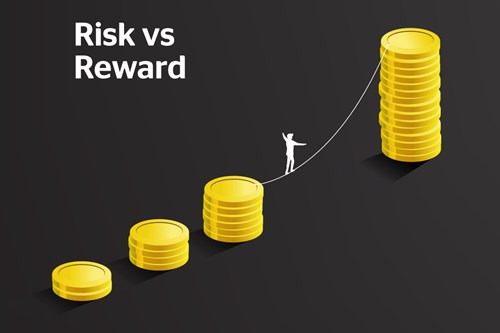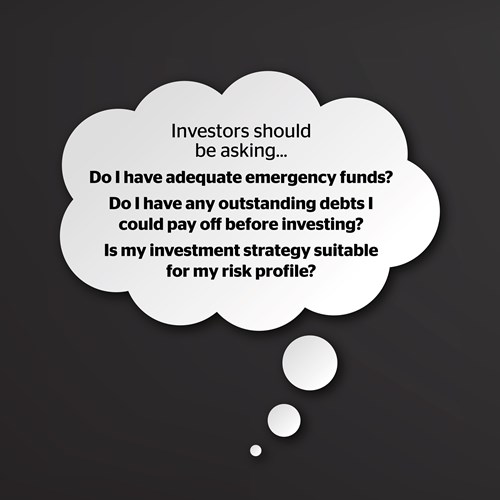
Jamie Mourant outlines some key considerations for first-time investors.
Investing can be an exciting and potentially rewarding endeavour. However, it is essential that one approaches investing with careful consideration and a clear understanding of what you are getting into. Whether you are new to investing or looking to refine your strategy, there are several crucial factors that investors must consider before diving into the world of financial markets.
Risk
Firstly, let’s look at risk. Risk, in the context of investing, is the uncertainty associated with investments. It is the potential for negative impacts on your financial well-being. Investing inherently involves risk, and comprehending and managing this risk is crucial for your long-term success.
Investing is a delicate balance between risk and reward. High-risk investments often come with the potential for substantial returns, but they also carry the possibility of significant losses. On the other hand, conservative investments provide stability but tend to offer lower returns. Striking the right balance between risk and reward is contingent upon your willingness to take risks to achieve your desired rewards.


With that in mind, it is vitally important that you assess your risk tolerance carefully. It is crucial to invest in assets that align with your comfort level. If you're risk-averse, you may want to focus more on conservative investments, such as bonds, whereas if you can tolerate higher risk, you might consider growth-oriented options such as equities.
Mitigating risk within an investment portfolio is crucial for safeguarding your financial well-being and increasing the chances of achieving your investment objectives. Diversifying your investment portfolio across different asset classes (e.g. stocks, bonds, commodities, property etc) can help spread risk. A diversified portfolio is less susceptible to significant losses in any one area. Diversifying your portfolio by holding a mix of assets, including stocks and bonds, can help reduce risk and improve the likelihood of achieving your financial objectives.
Investment timeframe
Arguably the most important factor in risk mitigation is the investment timeframe. Different investment objectives/goals and different life stages may require different timeframes for your investments. Here are some key considerations:
- Short-term vs. long-term
Are you investing for short-term goals (e.g. buying a car or going on holiday) or long-term objectives (e.g. retirement or buying a house)? Your timeframe will influence your choice of investments and risk tolerance. Longer-term goals may allow for higher equity allocation because they can withstand short-term market fluctuations. In contrast, as you approach retirement or your financial goal, you may gradually shift towards a more conservative mix, with a higher proportion of bonds.
- Liquidity needs
Assess your short-term liquidity needs. Ensure you have readily accessible funds for emergencies or unexpected expenses before committing to long-term investments.
- Volatility smoothing
Financial markets can be volatile in the short term, with prices fluctuating up and down. A longer investment timeframe allows you to ride out these short-term fluctuations and potentially benefit from the long-term growth of your investments. Moreover, having a longer investment horizon enables you to benefit from pound cost averaging. Consistently investing a fixed amount over time can help smooth investment returns and reduce the impact of market timing errors.
- Compounding
The longer you stay invested, the more time your money has to benefit from the power of compounding. This is where earnings/interest is reinvested to generate more returns over time.
Capacity for loss
Understanding your capacity for loss is a critical aspect of investing. This refers to the financial ability to withstand potential losses without compromising your overall financial well-being. Below are some things to consider:
- Emergency fund
Before investing, make sure you have an adequate emergency fund in place. This fund should cover essential living expenses and unplanned expenses (e.g. medical bills, car repairs etc).
- Debt management
Consider your outstanding debts, such as mortgage repayments, credit card balances or other loans. It makes sense to prioritise paying down high-interest debts before making any investment.
- Risk management
Be prepared for the possibility of losing some or all of your invested capital depending on what asset class you invest in. Avoid investing money that you cannot afford to lose. Economic cycles include periods of growth and periods of decline. As a first-time investor, it is important that you understand the volatility characteristics associated with different assets and proposed strategies that you might potentially invest in. To put this in context, when stock markets fell significantly during the 2008 global financial crisis, equity markets fell around -37% from their highest point in May 2008 to their lowest point in March 2009 (Source: MSCI World Index). As such it is important to ensure that the strategy you decide to invest in matches up with your risk appetite.

Investing can be a rewarding way to grow your wealth over time, but it's not without its risks. Before embarking on your investment journey, carefully consider your risk tolerance, investment timeframes, and capacity for loss. These factors will help you create a well-informed investment strategy that aligns with your financial goals and personal circumstances. Remember that investing is a long-term commitment, and being well-prepared will increase your chances of achieving financial success while minimising potential setbacks.
Ultimately, there's no one-size-fits-all answer and it's important to regularly review and adjust your portfolio to stay on track with your financial objectives. In that regard, it can often be beneficial to seek advice from an investment professional.

